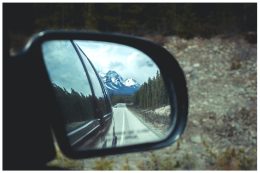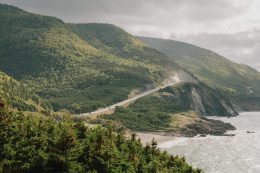How to Hike Safely and Responsibly in the North Shore Mountains
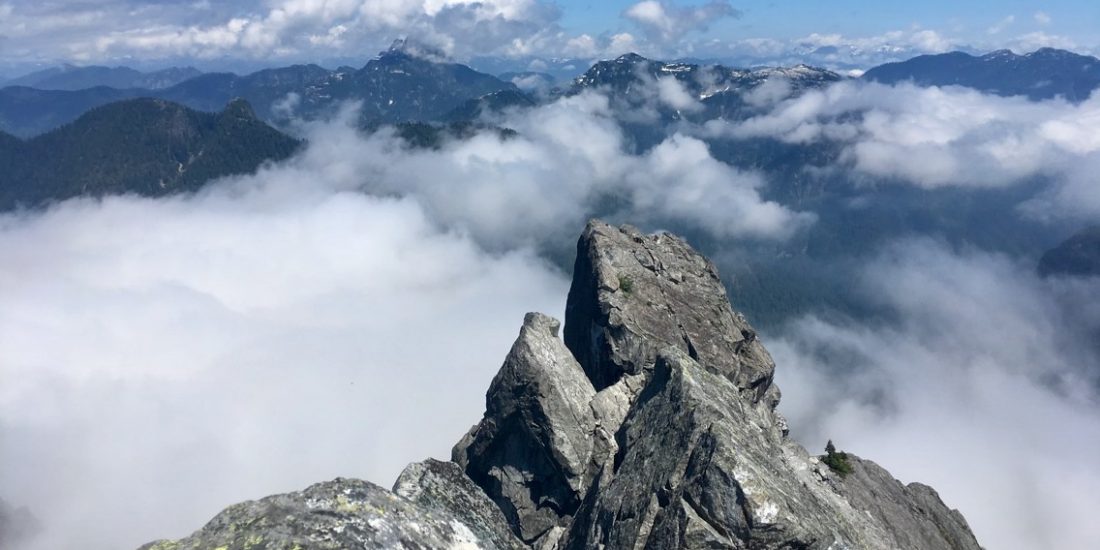
How to Hike Safely and Responsibly in the North Shore Mountains
Guest Blog by Ryan Village
Keeping up with our Changing Trails
The North Shore Mountains are a playground for adventurers of all backgrounds, and recognizing how the trails are changing is an important part of hiking and adventure safety. Despite the expensive real estate and high gas prices, Vancouverites are blessed with living only a Seabus away from large expanses of trail systems, easily accessible natural beauty and countless scenic viewpoints. Remember when you’re planning a hike that, like many of the neighbourhoods around our glorious city, the North Shore trails are changing.
Navigating Crowds on the Trails
The trails that ascend and traverse the granitic ridges and lush valleys of Vancouver’s North Shore have increased immensely in popularity over the last few years. The days when Lynn Canyon, St. Mark’s Summit or the Grouse Grind were quiet and peaceful on a Saturday afternoon in the summer are long gone. Hordes of selfie stick-toting tourists and locals alike flood the network of trails on a daily basis. It’s important to expect crowds, and learn how to navigate them.

Overall, more people accessing these areas is socially beneficial and educational, creating a healthier, happier population. On the other side, it can also be environmentally detrimental to the area (and sometimes straight up annoying to their long-time users.) Personally, I find that as long as the number of cute dogs increases with the amount of people, I don’t mind the crowds.
Maintaining the North Shore Trails
Our trails are changing physically, often for the worse. When the carrying capacity of a trail is exceeded, trails become wider, muddier, more technical and more exposed. Trail-widening damages fragile trailside vegetation and allows invasive plant species to thrive. Trails incur soil loss which prevents water from draining properly and exposes puddles and patches of mud. Roots and rocks also become exposed which damages trees, weakens soil structure and poses more challenges for trail users.
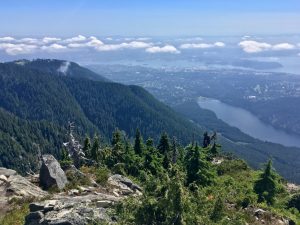
The Solution
The major solution to this dilemma is to “build up” the trail. Stairs, boardwalks, drainage systems and gravel pathways are built to minimize the aforementioned impacts. One of the best examples of this is the trail to Quarry Rock in Deep Cove. When I was a kid, the hike to this ultra-instagrammable viewpoint was rarely trodden and often quiet. The rickety “bouncy” bridges that used to span the steep creeks have been replaced with burly and sturdy counterparts that can withstand the daily traffic.
Did you know: Quarry Rock is the first trail on the North Shore where they have attempted to limit the number of hikers allowed at a time? This strategy is considered controversial by some, but has been successful in other areas, like the West Coast Trail.
Finding Information Online
The internet has changed our world, including how hikers approach the North Shore Mountains. There is a virtual encyclopedia of trip reports and hike descriptions that chronicle every stretch of trail, mossy outcropping and waterfall. Facebook and Instagram are huge depots of information (as long as you can put up with the occasional cheesy inspirational quote.)
You can go from knowing nothing about a route to quickly learning about distance, time required, elevation change, scenery, wildlife and even what type of Clif Bar you should bring. Being able to easily learn about local trails has immense positive benefits, such as hikers finding out what emergency supplies they’ll need, having access to maps and GPS tracks and discovering where to park so as not to disturb neighbours. At the bottom of this article in Trail Information and Resources are a few suggestions for great hiking resources in BC to help you get started.
Unreliable and Misleading Information
In our gorgeous summer months, social media becomes a hot bed of stunning photos taken from all across the various trails and peaks of the North Shore Mountains. These posts are often accompanied by no relevant or important information related to the hike, which really burns my bacon!
In April, a friend and I were hiking up a popular trail and passed a struggling man decked out in skate shoes and a muscle shirt, carrying nothing but a plastic water bottle. As my friend and I sat atop the summit of the half-day hike, he stumbled to the top behind us, took off his shirt and started flexing and posing for the camera (presumably for his Instagram account.) Don’t be that guy.
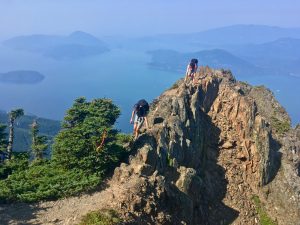
There is plenty of information online, and it’s not always easy to tell what’s useful. When researching online, it’s easy to underestimate the dangers of a difficult trail and attempt it unprepared, giving inexperienced recreationalists the ability to learn about routes beyond their skill level, where they are more likely to become injured or lost.
Tips for Researching the Trails
To avoid unreliable information, think about whether or not the recommendation you heard or the post you saw came from a credible, knowledgeable source. Misleading informaton can affect your safety, and the safety of others on the trail. We all have different fitness levels and goals, so take into consideration how that could affect your hiking group. Social media often shows us the aspirational side of enjoying the outdoors, but those scenic viewpoints are a reward for preparation and hard work.
When researching, always check more than one source. In addition to local blogs that will give you a sense of the trail experience, look for information from official municipal, provincial and federal Parks, Tourism and Search and Rescue sites for safety information. If you can, reach out to someone local who knows the trail firsthand.
Making a Difference on the Trails
In an ideal world, every party that ventures out into our local mountains would be properly prepared, realistic, responsible and return home safe at the end of the day. Regrettably, this is not the case and the selfless souls at North Shore Search and Rescue have been performing a record number of rescues annually. Search and Rescue organizations across the Lower Mainland and all over the Sea to Sky Corridor have been going into overdrive the past few years, so let’s see if we can give them a break.
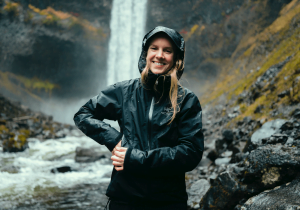
Whether you’re a hardcore local, or a summit socialite that’s stoked to see more people enjoying the environment, the reality is that all trail users are responsible for the well-being and longevity of the trails. It’s important to show respect for other trail users so that everyone can have an incredible experience venturing out into the mountains.
How can you help make a difference? Here are a few ways to actively improve the wilderness experience for all of us.
Be Prepared!
This is the most obvious tip, before you become a trail ambassador, you have to look out for yourself first. Before you go on a hike, research and learn basic knowledge about the route, like: how long it will take, when is the best time to go, the weather conditions for the day and specific route information. Remember to:
- ALWAYS take The Essentials which includes a signalling device, a first aid kit, extra food and water and warm clothing. They could very well save your life if something goes wrong.
- Don’t rely on your cell phone! Most of the hikes within the North Shore Mountains don’t receive cell service unless you’re at a higher elevation.
- Learn to use a map and compass and take them with you.
- Make a trip plan and tell someone where you’re going. If you were lost, could you survive the night(s), and would anybody know? Calling 911 and activating the brave, selfless and skilled men and women at North Shore Search and Rescue is for emergencies. It shouldn’t always be your first option, especially if you’re prepared.
Get Educated and Spread the Word
Organizations like AdventureSmart offer great resources online that can tell you all about being prepared for any outdoor activity at any time of year. If you’re unsure about your abilities, take a First Aid and/or Wildernes First Aid course, attend classes at your local MEC, plan an excursion with the BC Mountaineering Club or go on adventures with Yervana to hone your skills and explore the mountains safely. And don’t forget to tell your friends!
Be Courteous
Since we share trails with plenty of other people, there’s some basic etiquette to follow so you don’t get the stink eye from passersby.
- If you pack it in, pack it out! Don’t litter on the trail.
- When taking breaks or when letting faster groups pass you on the trail, step safely to one side.
- Don’t hog the best seat in the house! Make sure there’s plenty of room on the viewpoint for everyone to enjoy.
Speaking of viewpoint etiquette, nothing is worse than getting to the top of a mountain only to hear someone blasting Nickelback. Do us all a favour and leave the speakers at home.
Become a Trail Ambassador
We acquire so much happiness and health from being outside amongst the mountains, so why not give back? You can start by:
- Picking up garbage that you see on the trail.
- Don’t take shortcuts: it erodes the trail and the surrounding environment.
- In fact, block off shortcuts and fragile sections of the forest with sticks and debris if you can, and walk THROUGH puddles and muddy sections to prevent further trail widening.
- Learn about invasive plant species like English Ivy and Holly and pull them out when you see them on the trail.
Get Involved in Trail Days
If you’d like to learn about how our local trails are constructed and maintained, volunteer at a Trail Day. Awesome organizations like the North Shore Mountain Bike Association and the British Columbia Mountaineering Club help maintain our local trails.
Trail Information and Resources
This is just the tip of the iceberg when it comes to resources. Do your own research, learn about your route, and make educated and informed decisions before and during your hike. Here are some resources to get you started:
- “The Glorious Mountains of Vancouver’s North Shore: A Peak Bagger’s Guide” by David and Harry Crerar and Bill Maurer
- “Scrambles in Southwest British Columbia” by Matt Gunn
- “105 Hikes in and Around Southwestern British Columbia” by Stephen Hui
- AdventureSmart
- Vancouver Trails
- Outdoor Vancouver
Be prepared and have a blast. Go for a hike and do it right!
Ryan Village is from beautiful North Vancouver, and has worked as a zipline guide, a ski instructor and as a Vancouver area tour guide. He holds a diploma in Outdoor Recreation Management and Wilderness First Aid.

Let’s get social! Tap the links below to stay connected.
In Vancouver? Check out these adventures nearby!





